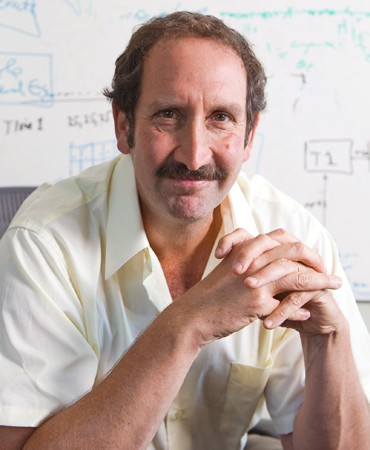This article is part of the Provost's Project on Innovation series

Image caption: Michael Miller
Image credit: Peter Howard
Michael Miller sees, and then he sees. The professor of biomedical engineering and director of the Center for Imaging Science is a pioneer in the field of computational anatomy, a discipline focused on the quantitative analysis of variability of biological shape. The object is to get a machine (an MRI, for instance) to compute a billion measurements and, essentially, see—not just record surfaces but understand. "Being able to have a machine do that is quite challenging," says Miller. "We don't have any machines that can literally go from the many, many measurements to knowledge representations. That really is the holy grail of image understanding."
To Miller, the painter Pablo Picasso and linguist Noam Chomsky have been among the world's best at decoding constructs—the essential task of truly seeing and understanding. Chomsky explored the connection between the surface and the deeper structures of language; in a similar way, Picasso deconstructed, analyzed, and reassembled surface images to achieve a deeper understanding in paintings such as Man with a Pipe done a century ago, early in the artist's cubist period. "There he really pushed us," says Miller. "He totally shattered the surface. He made it contradictory, yet always there was the concept of the man smoking the pipe. So we've been trying to do this for shape, form, and function in medical images, and that's what computational anatomy is."
Think of Miller as an innovator in building global positioning systems in human anatomy. The smartphone in your pocket has software built into it to help position you somewhere on the globe, so that when you ask to find the nearest Starbucks, it knows where to find each and bring you together. Computational anatomy does something analogous, looking at human tissue in health and disease states. The system Miller devised is called Diffeomapping—a system of building correspondences between like coordinates. The idea is based on mapmaking, only the points here are your own brain or heart and those of the world brain or heart, as in an image from Gray's Anatomy, which, in the map-making analogue, represents an atlas of sorts. "Now why that's interesting," says Miller, "is if you now have world coordinates in correspondence with your personalized brain or your personalized heart, then we can bring to bear all the knowledge that we have of world coordinates in the atlas. This is really the basis of personalized medicine. In the context of medical imaging we call this high-throughput imaging informatics."
The science is complicated—and occasionally arcane to the outsider—so Miller repeatedly references important innovators in other fields to illustrate his intents. Picasso and Georges Seurat, Chomsky and Claude Shannon are each called in turn, suggesting Miller's insight may be that perhaps the most complex problems involve the most disciplines. "Every problem that I've tried to solve has involved many different disciplines," he says, relating how as a grad student, he saw that Chomsky was doing with language what he was attempting to do with building global structures from images. He needed to understand how the brain understands, and Chomsky, he thought, had the answer, even though the linguist's work ultimately related to sentence structure.
Miller declares biomedical engineering to be a convergent discipline: "We don't have a choice if we work on biological systems but to bring people from different disciplines together," he says. "One of the things I can say about myself, which seems to be perhaps different from many others, is that I don't really think I am all that creative at solving puzzles or addressing long-standing problems that are well known in a field. But what I do seem to be good at is connecting dots."
That collaborative dot connecting has produced award-winning—and rewarding—work with many people outside his field: Ulf Grenander, whom he calls the greatest living mathematician; David Mumford, a Fields Medalist in algebraic geometry, with whom he won a National Science Foundation Award; and Laurent Younes, in the Department of Applied Mathematics and Statistics. "This just wouldn't be possible if we didn't have a research university," Miller observes. "I can't think of anything that I have done, any work that may be distinguished, that wasn't collaborative, that hasn't involved others helping me do it. It's very clear that you have to collaborate because of the range of problems." He could not do his own work without the help of people in applied mathematics, computational biology, radiology and other fields. The scale, he says, is too big. "So this idea of working on these convergent themes is key; they cross boundaries and it's challenging."
As for innovation, Miller says if you present something that someone else thinks is a good idea, then it's already out there. "When you write a paper that you think is an important paper, if it doesn't get completely destroyed in review, it's not an interesting paper." He recalls how his first paper on computational anatomy garnered reviews that he remembers as "scandalous."
But human history has shown a recurring resistance to new ideas; we're strong willed, and our beliefs are based on assumptions, oftentimes without proofs. As a good scientist, Miller says he needs only to be shown that he's wrong, and then he'll move forward with that. His advice to those, like him, with new ideas? "You have to do what you know is cool and you believe in." And the innovative possibilities of this new field of computational anatomy are something Michael Miller very much believes in. "I'm in the world, and I see Picasso and I know, I'm certain, that if Picasso were alive he would get this."
Posted in Health, Arts+Culture, Science+Technology
Tagged biology, michael miller, biomedical engineering, anatomy







